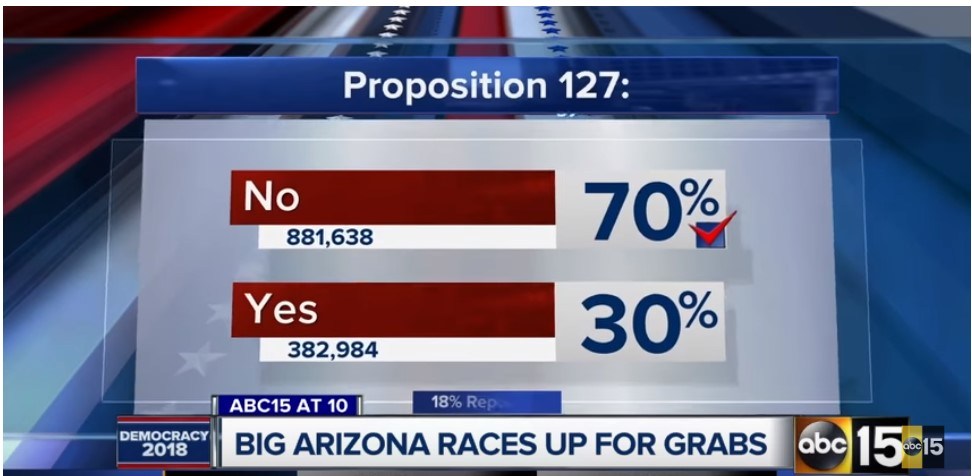Clean energy advocates Tom Steyer and the NRDC thought they had a winner with Arizona’s Proposition 127, which would have saved consumers money while helping the environment. But a huge burst of negative advertising by a local utility drove the measure down to defeat, while making this the most expensive Arizona election ever at $40 million.
By Charles W. Thurston
Cleantechnica
Proposition 127 required utilities operating in the state to source 50% of their energy from solar, wind, and other renewables. The state renewables energy portfolio standard is now 15% by 2025.
Clean Energy for a Healthy Arizona, a group backed by environmental advocate Tom Steyer, filed the proposal as an amendment to the state constitution that would require utilities to increase their renewables generation percentage by about 4% per year starting in 2020, with a minimum of 50% by 2030 and thereafter.
Clean Energy for a Health Arizona identifies itself as “a coalition of organizations and individuals, including Arizona doctors, nurses, labor unions, and small businesses, who know that this measure will improve public health and create good jobs for Arizona.”
Arizona Public Service, the largest utility in the state, opposed the amendment on the grounds that it would force the utility to retire existing non-renewable assets ahead of planned lifetime, stranding assets that might or might not be recoverable from the Arizona Corporation Commission.
APS serves about 2.7 million people in 11 of Arizona’s 15 counties. With headquarters in Phoenix, APS is the principal subsidiary of Pinnacle West Capital Corp.
While the utility is relying on new gas plants for its currently filed growth plans, it also has plans for more renewables in the future. APS issued a “peaking capacity” request for proposals in April for approximately 400-800 megawatts of capacity to meet peak demand beginning in 2021, specifically during the months of June through September. “APS will accept proposals for power purchase agreements for delivery to the APS system beginning no later than June 1, 2021,” according to the company RFP. APS also plans to issue other RFPs to solicit forest bioenergy solutions and battery retrofit opportunities for APS-owned solar facilities.
Jeff Deyette, the director of state policy and analysis for the Union of Concerned Scientists, said on November 5, “When Arizonans go to the polls tomorrow they’ll have a tremendous opportunity to take control of their energy future and put the state on the path to a much cleaner, healthier, more affordable power supply.”
Deyette adds “A recent study found that achieving the renewable energy requirements under Proposition 127 could save Arizona consumers as much as $4 billion between 2020 and 2030. That’s because the cost of solar and wind have dropped dramatically to the point where they are cheaper than new investments in fossil fuels, especially in places with strong resources like Arizona.”
The study was commissioned by the Natural Resources Defense Council (NRDC) and performed by energy analyst ICF. The study found that average electricity bills in 2030 would be $3 a month lower if Arizona pursues a high-renewables future, and $5 a month lower in 2040. The report was based on assumptions provided by NRDC based on publicly-available sources, the organization said.
The Solar Energy Industries Association assesses the solar policy climate in Arizona dimly: “While Arizona solar industry has tremendous growth opportunity, due to public debates about the benefits of solar, imposition of a net metering charge in 2014 and elimination of incentives, the market has been turbulent. SEIA is working with local stakeholders and policy makers to encourage stability and transparency into policies, so that the market can recover from this market disturbance and continue to grow.”
APS already has 10 solar generation plants in the state with a cumulative 1 million solar panels, and overall, 50% of the energy provided to customers is clean energy, including the Palo Verde nuclear station, the utility reports.
Arizona now has 3.6 GW of solar installed at an estimated cost of $8.2 billion, as the state with the third most installed solar generating capacity. About 536,000 homes in Arizona are solar powered, making solar energy the source of about 6% of the state’s total electricity generation by source, according to SEIA.


